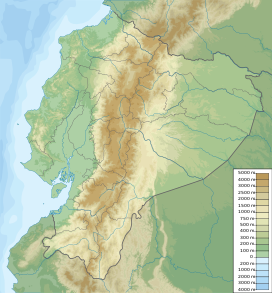
Rhaebo caeruleostictus is a species of toad in the family Bufonidae. It is endemic to Ecuador and occurs along the lower western slope of the Cordillera Occidental at elevations of 40–2,000 m (130–6,560 ft) asl. The specific name caeruleostictus, from Latin caeruleus (=blue) and Greek stiktos (spotted), refers to the bluish colour pattern of this species. Accordingly, common name blue-spotted toad has been coined for it.

Osornophryne sumacoensis is a species of toad in the family Bufonidae. It is endemic to the Ecuador and only found in the forests surrounding a small crater lake on the eastern slopes of Sumaco, a volcano in the Napo Province.

Hyloxalus elachyhistus is a species of frog in the family Dendrobatidae. It is found in southern Ecuador and northern Peru, in the Huancabamba Depression and south to Cajabamba Province.
Hyloxalus exasperatus or the Yapitya rocket frog is a species of frog in the family Dendrobatidae. It is endemic to Ecuador and found on the eastern slopes of the Andes in Pastaza and Morona-Santiago Provinces. However, it is suggested that specimens from Pastaza represent a different, possibly undescribed species.
Hyloxalus fallax is a species of frogs in the family Dendrobatidae. It is endemic to Ecuador and only known from the region of its type locality in the Cotopaxi Province, on the western slopes of the Andes. Common name Cotopaxi rocket frog has been coined for this species.
Hyloxalus fuliginosus or the Quijos rocket frog is a species of frog in the family Dendrobatidae. It is endemic to Ecuador where it is known from the Amazonian slopes of the Andes in the northern Ecuador, with some sources reporting it from Colombia and Venezuela.
Hyloxalus maquipucuna is a species of frog in the family Dendrobatidae. It is endemic to Ecuador where it is only known from its type locality in the Maquipucuna reserve, in the Pichincha Province.
Hyloxalus mystax is a species of frog in the family Dendrobatidae. It is endemic to Ecuador where it is only known from its type locality on the Cordillera del Cóndor at 1,830 m (6,000 ft) asl.
The marbled poison frog or marbled poison-arrow frog is a species of frog in the family Dendrobatidae found in western Colombia and northwestern Ecuador, at elevations of 10–1,500 m (33–4,921 ft) asl. It likely represents a species complex of at least two species.

The Imbabura tree frog is a species of frog in the family Hylidae found in the Pacific lowlands of western Colombia and northwestern Ecuador from the sea level to 1,000 m (3,300 ft) asl.
Pristimantis balionotus is a species of frog in the family Strabomantidae. It is endemic to Ecuador and only known from its type locality on the border between the Loja and Zamora-Chinchipe Provinces, near the crest of the Ecuadorian Andes. Common name crest robber frog has been coined for it.
Strabomantis cornutus is a species of frog in the family Strabomantidae. It is found along the eastern flank of the Andes of Ecuador and Colombia north to Caquetá Department. Common name Rio Suno robber frog has been coined for it. It has been confused with other species.

Pristimantis curtipes is a species of frog in the family Strabomantidae. It is found in the Nariño Department of southern Colombia and in the Andes of Ecuador south to Desierto de Palmira.
Pristimantis ernesti is a species of frog in the family Strabomantidae. It is endemic to the summit of Sumaco, a volcano in the Napo Province, Ecuador. Its common name is Ernest's robber frog. It is named after Dr. Ernst Williams, a friend and colleague of the scientist that described the species. It is a little studied species.
Pristimantis esmeraldas is a species of frog in the family Strabomantidae. It is found in north-eastern Ecuador in Esmeraldas and Manabí Provinces and in Valle del Cauca Department in Colombia.
Pristimantis luscombei is a species of frog in the family Strabomantidae. It is known from north-eastern Peru, adjacent Amazonian Ecuador, and from Acre state, Brazil. Some of the paratypes were later identified as belonging to another species, described in 2014 as Pristimantis miktos. At the same time, Pristimantis achuar was identified as synonym of Pristimantis luscombei.

Pristimantis scolodiscus is a species of frog in the family Strabomantidae. It is found on the Pacific slopes of the Andes in northern Ecuador and in the Colombian Massif in the Nariño Department in the adjacent south-western Colombia. Its elevational range is 1,200–1,780 m (3,940–5,840 ft) above sea level.
Pristimantis vertebralis is a species of frog in the family Strabomantidae. It is endemic to the Andes of Ecuador and occurs in the Carchi, Imbabura, Pichincha, Cotopaxi, Bolívar, and Azuay provinces. Common name vertebral robber frog has been coined for it.
Noblella lochites, also known as Ecuador leaf frog, is a species of frog in the family Strabomantidae. It is found on the Amazonian slopes of the Andes and Cordillera del Cóndor and the Cordillera de Cutucú in Ecuador and Peru; the Peruvian record has been disputed, although it is nevertheless expected that the species occurs in Peru.

Sumaco Napo-Galeras National Park is a protected area in Ecuador situated in the Napo Province, Orellana Province and Sucumbíos Province. The highest point of the park is the Sumaco volcano that peaks at 3,732 m; the lowest altitude is 600 m.








